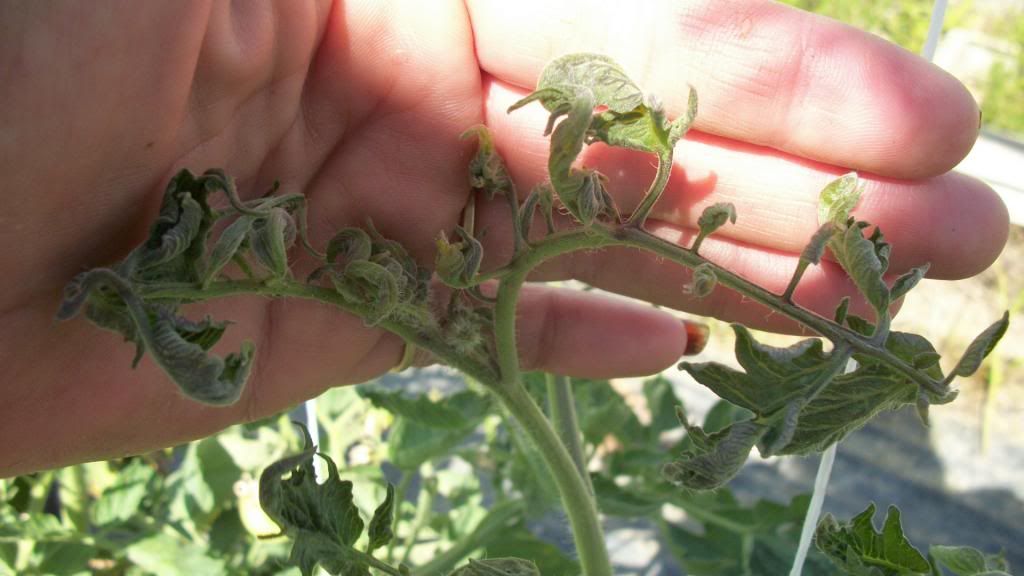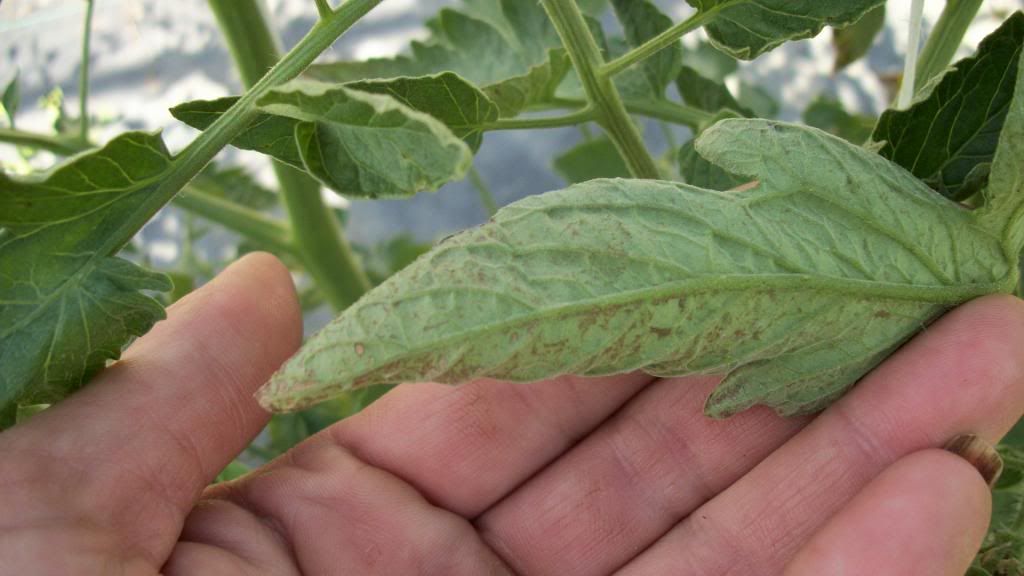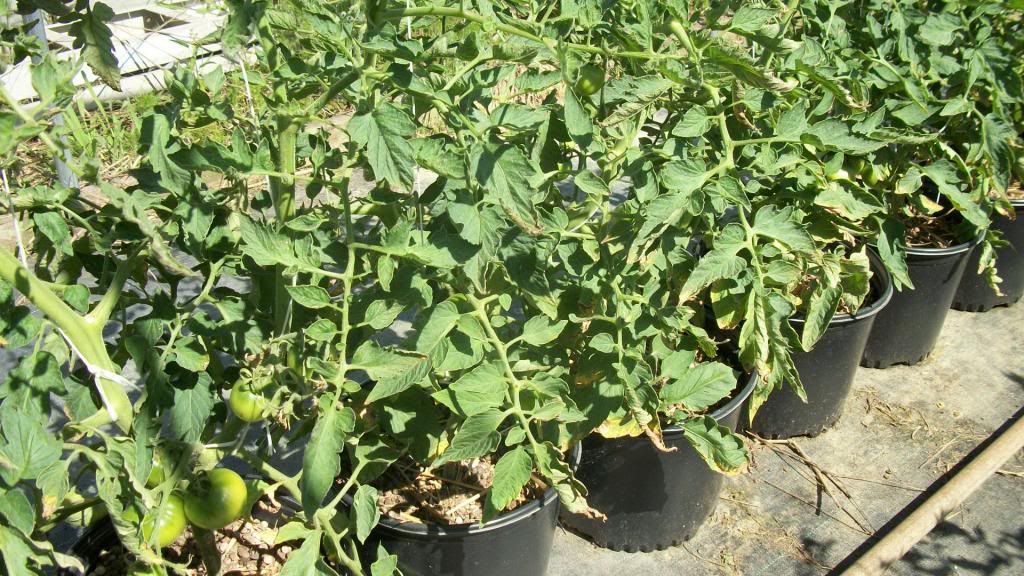

|
Information and discussion regarding garden diseases, insects and other unwelcome critters.
|
 |
|
|
Thread Tools | Display Modes |
|
|
#1 |
|
Tomatovillian™
Join Date: Oct 2010
Location: Nauvoo, Alabama
Posts: 184
|
There is an area of my yard set up to grow tomato plants in containers but everytime I grow in that area the plants end up with tight curly new growth and black smutty specks on the lower leaves and once I took a plant to the Ag depart and they did say the plant had thrips but they never said anything about TSWV. The TSWV is my own dignosis.
I want to clean up the area this summer and get rid of the thrips and make it safe for growing tomatoes again. What would you suggest to use for getting rid of the thrips and how often to kill out the new thrips that have hatched and how long do you think it will take to clean out the thrips? The area is next to a field but not my field. There is a narrow section of field on my land and I normally don't cut it because it stays wet most of the year and hard to get a mower in there but lately I have been mowing it with the deck set up high to stay out of the moist soil just to get the grass cut. I have been spraying the whole surrounding area with seven dust.
__________________
Happy Gardening  Carolyn Last edited by CarolynPhillips; May 25, 2013 at 10:38 AM. Reason: to add |
|
|

|
|
|
#2 |
|
Tomatovillian™
Join Date: Oct 2010
Location: Nauvoo, Alabama
Posts: 184
|
__________________
Happy Gardening  Carolyn |
|
|

|
|
|
#3 |
|
Tomatovillian™
Join Date: Feb 2012
Location: Maryland's Eastern Shore
Posts: 993
|
Carolyn,
My understanding is that thrip poulations develop high chemical resistance very quickly. This because they can turn out a new generation in just a few weeks. One would need to rotate through several products with different active ingredients to maintain control and spray frequently. There are some predatory mites used commercially but I do not know if any of them would be effective in your setting. Keeping surrounding vegetation further back and cut short is probably your first best start. Like aphids, control is your goal as you will likely never really be rid of them. Good luck.
__________________
George _____________________________ "The tree of liberty must be refreshed from time to time with the blood of patriots and tyrants. It is it’s natural manure." Thomas Jefferson, 1787 |
|
|

|
|
|
#4 | |
|
Tomatovillian™
Join Date: Feb 2012
Location: Maryland's Eastern Shore
Posts: 993
|
Quote:
You posted even as I was writing... Those things would seem to hold greater promise than just a chemical control approach for sure! It would be nice to know more about the bacteria they speak of.
__________________
George _____________________________ "The tree of liberty must be refreshed from time to time with the blood of patriots and tyrants. It is it’s natural manure." Thomas Jefferson, 1787 |
|
|
|

|
|
|
#5 |
|
Tomatovillian™
Join Date: Jun 2010
Location: Cheektowaga, NY
Posts: 2,468
|
The bacteria in Mosquito Dunks is Bacillus thuringiensis israelensis (Bti). More info here
It is a different species of Bt from the Bacillus thuringiensis kurstaki that targets only caterpillars. |
|
|

|
|
|
#6 |
|
Tomatovillian™
Join Date: Sep 2009
Location: Alabama
Posts: 7,068
|
Carolyn, the black smutty specks on the lower leaves doesn't sound like TSWV; but the tight curled new growth is a symptom. TSWV usually hits first higher up the plant in the form of little rust like flecks in the leaves that can range in color from brownish yellow to almost black. It usually shows up on newer leaves and a week or so later you start seeing the new growth tips curl and get a slightly burned look to the edges sometimes. Another dead giveaway is the plant virtually stops growing compared to all the ones around it. It can take anywhere from a week on a very young plant to a couple of months on a large healthy plant for it to totally kill. If I am certain a plant has TSWV and it has no fruit large enough to ripen shortly then I go right ahead and pull it. If it has toms nearly mature I will leave it and see how it progresses. The plants with small fruit are a toss up. If the plant seems especially vigorous and still growing decent then I will leave it for a while but if is sickly looking and not growing then I pull it.
I don't know where Nauvoo is but down here in the SE corner of the state I get thrips every year. Usually they hit worst in the spring when my plants are about 3 to 4 ft tall and just starting to set fruit. They seem to come in waves for a few days to a week and then go away. Sometimes they return once or twice more during the season. I can usually count on having from a few to a third of my plants start showing symptoms a few weeks after I first see the thrips. It appears that not all of them carry the virus because if they did I don't think a single plant would escape. This year despite a host of thrips I have only had two plants develop TSWV. One year when they were really bad and showing up more frequently than is the norm and also making more of my plants sick, I sprayed the plants almost every day killing thousands of them over a weeks time. I got no infections from that wave of thrips but it was a lot of work and I'm not sure how practical it is. I can't say for sure the spraying even stopped the infection. I may have just had a bunch of thrips that weren't carrying the virus. Now I just make sure that at least through mid June I have replacement seedlings ready to go in case I get a bad hit from TSWV. It seems to be the easiest solution I have found. Good Luck. Bill |
|
|

|
|
|
#7 |
|
Tomatovillian™
Join Date: Nov 2010
Location: San Diego
Posts: 1,255
|
Carolyn,
What you are describing doesn't sound like TSWV. The curly new growth could be caused by thrips feeding (without transmitting TSWV) and is typical of a bad thrips infestation. The black spots on the bottom leaves would be another problem - probably fungal, but hard to guess without photos. Controlling thrips is difficult and, at certain times of the year, nearly impossible in a residential setting. Commercial growers use systemic pesticides (yes, on tomatoes) and other contact pesticides not available to homeowners and then spray often, they surround their fields with fences of yellow/blue sticky tape, they use plastic mulches (silver reflective mulches have proven useful in field studies). Still, they will lose a portion of their crop to TSWV. I expect to lose a good portion of my plants to TSWV every year. I use only organic controls like spinosad and neem oil to get some control. I also try to keep all of the upwind weeds cultivated for as far as possible. (This is where residential thrips control is difficult - you can't go into your neighbor's yard and cut down all of their plants bearing thrips.) The BT you linked to would be partially effective in a greenhouse but I doubt it would be worth the effort outdoors. If I were you I would use a combination of yellow sticky traps, organic pesticides labeled for thrips control, and possibly (depending on your budget) silver reflective mulch and beneficials. The combination should make it possible to get a reasonable harvest in your target area. Good luck! Steve Last edited by Heritage; May 25, 2013 at 03:22 PM. |
|
|

|
|
|
#8 |
|
Tomatovillian™
Join Date: Oct 2010
Location: Nauvoo, Alabama
Posts: 184
|
I can't get a photo of how they looked at first because since then, I had an attitude that I was either gonna kill the thrips or I was gonna kill the plants and I sprayed them heavy with liquid seven and dish detergant..... heavy was 3 tbs a gallon. I think that caused the leaves to burn on the tips cause at first I saw the run off of the spray on the tips of the leaves and a couple days later it was burned.
the black specks I saw wasn't actually smutty. the leaves below the new growth had black specks under the leaves as if something was sucking the life out of it. I can find a leaf. the plants were dark healthy green and still are.......... Ok........let me go take pictures.
__________________
Happy Gardening  Carolyn |
|
|

|
|
|
#9 |
|
Tomatovillian™
Join Date: Oct 2010
Location: Nauvoo, Alabama
Posts: 184
|
THE CURLY TOPS = mostly on celebrity but now showing up on rutgers and delicious and some big beef
 The top sides of the leaves were green but the bottom sides had black specks , some brown, some brown blotches.  the field next door  I burned some of the leaves and blossoms spraying for the thrips.  After the tops didn't straighten out , I stopped fertilizing 10 days ago but I kept watering. Today I was ready to pull the plants and burn them. Fruits are golf ball size. There is also little black nats on all the stems.
__________________
Happy Gardening  Carolyn |
|
|

|
|
|
#10 |
|
Tomatovillian™
Join Date: Nov 2010
Location: San Diego
Posts: 1,255
|
Carolyn,
Photo #1 is probably herbicide damage but could also be CMV (Cucumber Mosaic Virus). It is difficult to tell them apart. Are all of the plants showing the curly/fernleaf damage in photo #1 located in the same general area or is it a random pattern of infliction? Are the gnat-like creatures on your stems aphids (winged)? Is the soil in the infected plants' pots the same mixture as the soil in the uninfected pots? Has anyone sprayed any herbicide anywhere near your plants in the past several months? Steve |
|
|

|
|
|
#11 |
|
Tomatovillian™
Join Date: Oct 2010
Location: Nauvoo, Alabama
Posts: 184
|
photo #1 ====same plants that are in the same row are all infected , some more than others. Over in another area there were two plants that have the same problem but no other. Had a couple of pepper plants that did the same thing but they have been thrown away and they were also in a differant area .
The gnats are not aphids. The gnats are tiny black bodied bugs with long clear wings. The soil is the same type of mixture but came from different bags and bales of soil and the infected has different batches of soil There was an herbicide truck in the neighborhood about a month ago. The tight curl started on celebrity tomato plants. Later it showed up on Rutgers in the same area. A few days later, the Delicious in same area, and at the same time two big beef in a different area that also has many plants. It's a hit and miss in differant areas but the worst is next to the field.(46 plants)
__________________
Happy Gardening  Carolyn |
|
|

|
|
|
#12 |
|
Tomatovillian™
Join Date: Nov 2010
Location: San Diego
Posts: 1,255
|
Carolyn,
Herbicides can cause damage from a surprising distance and direct drift from spraying or indirect vapor drift from dried spray (several days later) can cause the symptoms you are seeing. However, if the drift was coming from a distance then I wouldn't expect just the outside row to show symptoms. I think the herbicide would have to have been applied fairly close to the outer row of containers to affect just the outer row. A perimeter treatment (several feet from the containers) a few months ago would show this effect if the temperature reached the vapor point of the dried herbicide and the vapor drifted to the plants. Often herbicide damage doesn't show until the weather warms up. The insect vector for CMV is aphids so, if you had seen aphids on the outer row of plants I would suspect an invasion of CMV carrying aphids from the adjoining field. They would affect mainly the outside row. So, I'm still leaning towards herbicide damage but I think it is important to eliminate CMV as a possibility. There is a difference in your next actions depending on if it is CMV or if it is herbicide damage. You might give ACES a call and ask if they have a branch in your area that does testing for viruses. http://www.aces.edu/home-garden/lawn-garden/index.php If your extension agency doesn't do testing you can order CMV ImmunoStrips from Agdia and do the testing yourself. The tests are simple to do and fairly reasonable (about $40 for 5 tests with shipping) https://orders.agdia.com/InventoryD....tribute_Size=5 (they also make a test for TSWV you might find useful) CMV can be transmitted mechanically so, until you get a negative diagnosis for CMV, you should only handle or prune the questionable plants last and sterilize tools after using them. I understand how frustrating it can be to see 'that' twisted foliage - I have about 50 plants showing the exact symptoms as in your photo #1. They tested negative for both CMV and TMV. (and I have since discovered the source of the herbicide). Good luck with your diagnosis!  Steve |
|
|

|
|
|
#13 |
|
Tomatovillian™
Join Date: May 2013
Location: Central Indiana 6a/41
Posts: 131
|
My understanding is that tomatoes are perhaps the most sensitive to herbicide drift. The drift could even be from next door or across the street.
__________________
Russel USDA: Zone 6a, Sunset Zone 41 - 15 miles NW of Indianapolis, IN I had a problem with slugs. I tried using beer but it didn't work, until I gave it to the slugs. |
|
|

|
|
|
#14 |
|
Tomatovillian™
Join Date: Oct 2010
Location: Nauvoo, Alabama
Posts: 184
|
Thank you Steve and thanks for links for the test. I hate to spend the money on it but I think I might order those CMV test. Thank you everyone for all your help and advice.
I inspected all these plants for aphids and found None. I do have aphids on some other plants 75 ft away but even those plants with the aphids don't show any problems. I have a wild elderberry that has curly leaves 200 ft further back away from the tomato plants that have the curly leaves and the ones with the severe curly leaves are close to the road shown in one of the pictures above which is the road I saw the herbicide truck traveling down and those tomato plants also get the west winds. All the other tomato plants were on the other side of structures that may have blocked an herbicide drift. If it is herbicide damage, how long does it normally take to grow out of it? It rained hard on the plants after they had tight curly growth 3 weeks ago and I would think it would be gone by now. The leaves that use to be young and curly are now folded out and cupped upward with dry edges. The plants are still growing and just now growing a new set of bloom buds . I guess I should just watch the plants for another week and see what happens. Seems like no matter what the problem is, the production is damaged and I really don't want CMV to spread to other plants if that is what it is. I might relocate the uninfected plants. It won't be the best set up but at least they won't be near the problem.
__________________
Happy Gardening  Carolyn |
|
|

|
|
|
#15 |
|
Tomatovillian™
Join Date: Nov 2010
Location: San Diego
Posts: 1,255
|
Carolyn,
I think if you had CMV you would be seeing more typical shoestring leaves on at least some of the infected varieties. Given your other info, I would put my guess of probability that you have herbicide damage at about 80%. With the small chance you have CMV (or another virus) your strategy to "isolate and observe" seems a good one. Since aphids would have to feed on the infected plants and then fly to your other plants to infect them the chances of CMV spreading should be small. Also, you should work on those plants last and sterilize tools after working on them to avoid spreading CMV mechanically. It is difficult to say how long it will take to grow out of the damage. Was the herbicide truck doing weed abatement along the road you mentioned? If they sprayed herbicide upwind of your garden it is possible (depending of the herbicide they used) that fumes are still being released, especially on the hot days. 200 feet seems like a long distance for this to still have an ongoing effect but just a thought. Since you are seeing new growth and blossoms, my guess is that your plants have a good chance of recovering and producing a good crop of fruit. My similarly damaged plants, with damage from herbicide in the soil, are not blooming or setting fruit. I think your herbicide drift should have a more optimistic prognosis than herbicide in the soil mix itself. Please keep us posted, I'm very interested in your progress with this!  Steve |
|
|

|
 |
|
|
